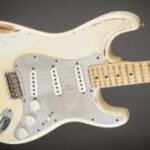The Bsus chord, encompassing both Bsus2 and Bsus4, is a versatile and evocative chord for guitarists. Often referred to as a suspended chord, the Bsus family omits the major or minor third, replacing it with either a major second (sus2) or a perfect fourth (sus4) from the root. This alteration creates a unique, unresolved tension that can add depth and interest to your guitar playing. Let’s dive into understanding and playing the Bsus chords on guitar.
Understanding the Bsus Chord Family: Bsus2 and Bsus4
Both Bsus2 and Bsus4 chords share the root note B and the perfect fifth F♯. The key difference lies in the suspended note:
- Bsus2 Chord: Features a major second (C♯) instead of the third. The notes are B, C♯, F♯.
- Bsus4 Chord: Features a perfect fourth (E) instead of the third. The notes are B, E, F♯.
This suspension creates a characteristic sound. Suspended chords, by their nature, feel like they are “hanging” or unresolved, often resolving to a major or minor chord. This inherent tension makes them powerful tools for creating musical interest and emotional depth in progressions.
To visualize these chords in a broader musical context, understanding their piano counterparts can be helpful.

